Nowadays a lot of audio versions of the Rubáiyát are available. Early recordings were done on lp in 1955 by Jim Ameche, Ralph Bellamy and Raymond Massey. These are usually FitzGerald’s versions, and some are with background music.
Recent recordings (a first selection, more will follow):
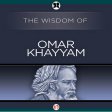 The Rubaiyat of Omar Khayyam. By E.F. Thompson. Narrated by Mark Turetsky.
The Rubaiyat of Omar Khayyam. By E.F. Thompson. Narrated by Mark Turetsky.
Audible Inc., 2013.
Time: 2 hours, 3 minutes.
From Audible, an Amazon company.
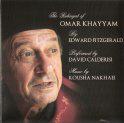 The Rubaiyat of Omar Khayyam. Translated by Edward FitzGerald. Narrated by David Calderisi.
The Rubaiyat of Omar Khayyam. Translated by Edward FitzGerald. Narrated by David Calderisi.
Published by David Calderisi, 2012.
Time: about 60 minutes.
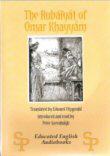 The Rubaiyat of Omar Khayyam. Translated by Edward FitzGerald. Introduced and read by Peter Greenhalgh.
The Rubaiyat of Omar Khayyam. Translated by Edward FitzGerald. Introduced and read by Peter Greenhalgh.
English Speech and Pronunciation, 2012.
Time: 30 minutes.
From: AudioAndBooks.com.
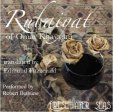 Rubaiyat of Omar Khayyam. By Edward FitzGerald. Narrated by Robert Bethune.
Rubaiyat of Omar Khayyam. By Edward FitzGerald. Narrated by Robert Bethune.
Freshwater Seas, 2010.
Time: 34 minutes.
From Audible, an Amazon company.
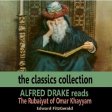 Alfred Drake reads The Rubaiyat of Omar Khayyam. By Edward FitzGerald.
Alfred Drake reads The Rubaiyat of Omar Khayyam. By Edward FitzGerald.
Saland Publishing, 2009.
Time: 22 minutes.
From Audible, an Amazon company.
 The Rubaiyat of Omar Khayyam explained. By Paramhansa Yogananda. Narrated by Donald J. Waters.
The Rubaiyat of Omar Khayyam explained. By Paramhansa Yogananda. Narrated by Donald J. Waters.
Cristal Clarity Publishers, 2006.
Time: 6 hours, 27 minutes.
From Audible, an Amazon company.
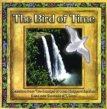 The Bird of Time. Selections from The Rubaiyat of Omar Khayyam explained. Voice and instrumentation by Swami Kriyannda.
The Bird of Time. Selections from The Rubaiyat of Omar Khayyam explained. Voice and instrumentation by Swami Kriyannda.
Cristal Clarity Publishers, 2006.
Time: 1 hour, 1 minute.
From Audible, an Amazon company.
Another important resource is Internet Archive, which has a collection of recordings by LibriVox, read by volunteers. Here you will also find other translations than those by FitzGerald. And of course there is YouTube with lots of footage and recordings. A selection will follow soon.
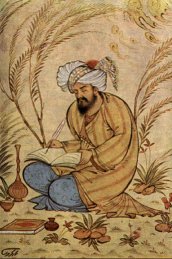 The Library of Congress opened an exhibition on March 29, titled “A Thousand Years of the Persian Book”. Purpose of the exibition is to take visitors on a visual journey of the rich literary history of Persian language, and to explore works of religion, science, modern literature, children’s books, women’s literature and the highly illustrated masterpieces of classical poetry for which Persian literature is most famous.
The Library of Congress opened an exhibition on March 29, titled “A Thousand Years of the Persian Book”. Purpose of the exibition is to take visitors on a visual journey of the rich literary history of Persian language, and to explore works of religion, science, modern literature, children’s books, women’s literature and the highly illustrated masterpieces of classical poetry for which Persian literature is most famous.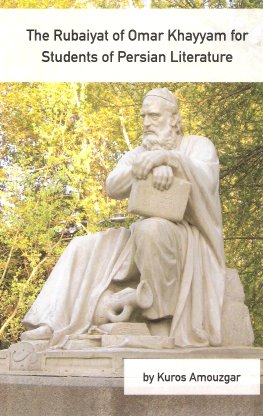 Kuros Amouzgar, educated as an engineer and living in the USA, translated the Persian text of Furughi and Ghani’s edition of the Rubáiyát, to help his children’s generation enjoy their Persian literary heritage. These children of Iranians living outside their homeland, often lack knowledge and understanding of the Persian language and literature. Khayyám is one of the most famous and well known Persian poets and his verses are easier to comprehend and to translate than other Persian poets.
Kuros Amouzgar, educated as an engineer and living in the USA, translated the Persian text of Furughi and Ghani’s edition of the Rubáiyát, to help his children’s generation enjoy their Persian literary heritage. These children of Iranians living outside their homeland, often lack knowledge and understanding of the Persian language and literature. Khayyám is one of the most famous and well known Persian poets and his verses are easier to comprehend and to translate than other Persian poets.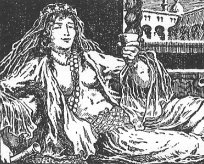
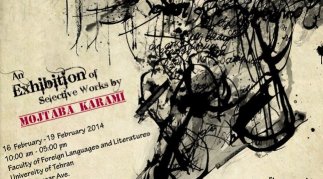
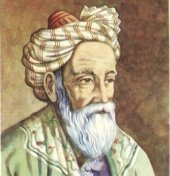 Quatrains from Khayyam’s poetry were performed by Opera singer Lynly Butt and the film on the life and times of Khayyam “The Keeper — The Legend of Khayyam” was screened. However, in Professor Kazi´s view “the directors and producers commercialise and distort the history.”
Quatrains from Khayyam’s poetry were performed by Opera singer Lynly Butt and the film on the life and times of Khayyam “The Keeper — The Legend of Khayyam” was screened. However, in Professor Kazi´s view “the directors and producers commercialise and distort the history.”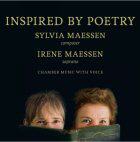 Inspired by Poetry, as the CD is called, contains a number of songs, based on texts by a number of Dutch poets, and by Rutebeuf, Khlebnikov and Tullia d’Aragona, in a variety of musical settings.
Inspired by Poetry, as the CD is called, contains a number of songs, based on texts by a number of Dutch poets, and by Rutebeuf, Khlebnikov and Tullia d’Aragona, in a variety of musical settings.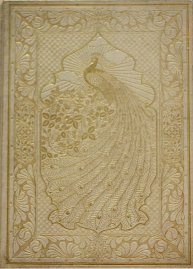
 The Rubaiyat of Omar Khayyam. By E.F. Thompson. Narrated by Mark Turetsky.
The Rubaiyat of Omar Khayyam. By E.F. Thompson. Narrated by Mark Turetsky. The Rubaiyat of Omar Khayyam. Translated by Edward FitzGerald. Narrated by David Calderisi.
The Rubaiyat of Omar Khayyam. Translated by Edward FitzGerald. Narrated by David Calderisi. The Rubaiyat of Omar Khayyam. Translated by Edward FitzGerald. Introduced and read by Peter Greenhalgh.
The Rubaiyat of Omar Khayyam. Translated by Edward FitzGerald. Introduced and read by Peter Greenhalgh. Rubaiyat of Omar Khayyam. By Edward FitzGerald. Narrated by Robert Bethune.
Rubaiyat of Omar Khayyam. By Edward FitzGerald. Narrated by Robert Bethune. Alfred Drake reads The Rubaiyat of Omar Khayyam. By Edward FitzGerald.
Alfred Drake reads The Rubaiyat of Omar Khayyam. By Edward FitzGerald. The Rubaiyat of Omar Khayyam explained. By Paramhansa Yogananda. Narrated by Donald J. Waters.
The Rubaiyat of Omar Khayyam explained. By Paramhansa Yogananda. Narrated by Donald J. Waters. The Bird of Time. Selections from The Rubaiyat of Omar Khayyam explained. Voice and instrumentation by Swami Kriyannda.
The Bird of Time. Selections from The Rubaiyat of Omar Khayyam explained. Voice and instrumentation by Swami Kriyannda.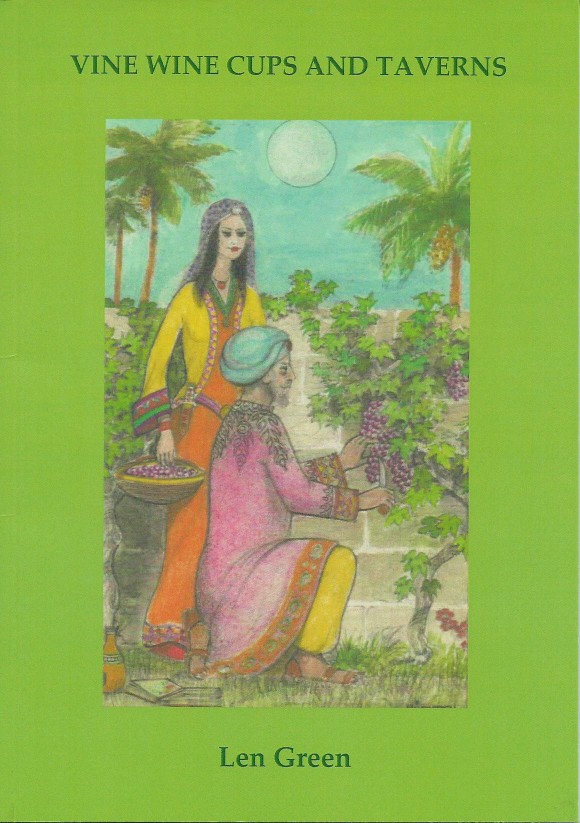 Len Green, from Australia, has just issued another book with selections from various translations of Khayyám’s verses, dedicated almost entirely to Omar’s wine quatrains and everything one needs to enjoy a good bottle: the vine, the grape, the juice, the draught, Saki, cup and cupbearers, bowls and bottles, jugs and jars, flasks and flagons, the rose and the tulip and of course your loved one.
Len Green, from Australia, has just issued another book with selections from various translations of Khayyám’s verses, dedicated almost entirely to Omar’s wine quatrains and everything one needs to enjoy a good bottle: the vine, the grape, the juice, the draught, Saki, cup and cupbearers, bowls and bottles, jugs and jars, flasks and flagons, the rose and the tulip and of course your loved one.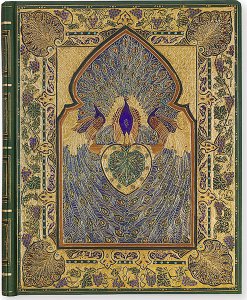 The Peter Pauper Press, well known for a number of editions of the Rubáiyát, have now issued a so called Great Omar Journal, a notebook providing 192 blank, lightly-lined pages “for personal reflection and creative expression”. The covers are taken from the famous Sangorski & Sutcliffe binding.
The Peter Pauper Press, well known for a number of editions of the Rubáiyát, have now issued a so called Great Omar Journal, a notebook providing 192 blank, lightly-lined pages “for personal reflection and creative expression”. The covers are taken from the famous Sangorski & Sutcliffe binding.